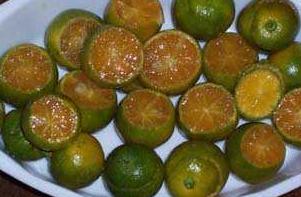The Luz calamansi is a fast grower, prolific and is much juicier than the native variety. Moreover, it has only two seeds compared to native calamansi which has 12 seeds. The Luz calamansi variety is ideal for container growing and bears fruits continuously throughout the year.
(!!! THIS WEBSITE IS UNDER CONSTRUCTION !!!)
Luz Calamansi
The Luz calamansi is a fast grower, prolific and is much juicier than the native variety. Moreover, it has only two seeds compared to native calamansi which has 12 seeds. The Luz calamansi variety is ideal for container growing and bears fruits continuously throughout the year.
Abiu (Pouteria caimito) Fruit Tree
| |
|
Eight Ways to Get Rid of Aphids Naturally
Is it important to get rid of aphids and insect pests in your garden? Aphids have sharp mouths that pierce plant tissue allowing them to feed off plant sap. They subsequently secrete a sugary honeydew over leaves (this unfortunately attracts ants that happen to love eating the sap). They may attack all parts of the plant but new, vulnerable growth is their preference. Most problematic, some aphids can transmit viruses to other plants in your garden -- causing a variety of problems overall .
Here are tactics for removing aphids from your plants and garden organically:
Variegated chico is prolific and sweet
It bears a lot of fruits year-round. Its medium-size fruits are fine-textured and very sweet. It is also very decorative because of its green and yellow leaves. That’s the variegated chico which is both an economic and decorative plant.
The variegated chico was introduced in the Philippines way back in the early 1980s. The fellow responsible for that was the late John Mesina, a commercial pilot who also had a sideline in orchids, ornamentals and fruit trees. For many years, the variegated chico remained in the hands of just a few fruit fanciers because there were just a few propagations available. Mesina’s son, Bobby, just multiplied it by marcotting which is a very slow process. Moreover, marcotted variegated chico does not grow very well because it does not have a tap root.
It was only when grafting was resorted to just about five years ago that the fruit tree has become available in big numbers. Today, it is being mass propagated
How to make Compost
To achieve self-sufficiency in rice, production must be pursued within a sustainable framework, one that meets the country’s current food demand and yet protects the environment. The use of organic fertilizers, such ascompost, either alone or in combination with inorganic fertilizers, is one of the measures incorporated in the Agrikulturang MakaMASA program to promote sustainable crop production.
Past efforts to promote compost-making have been constrained, to a large extent, by the relatively low cost of chemical fertilizers. But even with the increased cost of fertilizers in recent years, few farmers adopted this technology because of the following reasons:
- It takes a long time to produce
- It takes large quantities of raw materials.
- It is laborious.
- Beneficial effects on the soil are not easily seen or felt.
But now, composting technology has considerably improved so that compost can be made in just 3-4 weeks!
What is a Compost?
Subscribe to:
Posts (Atom)




